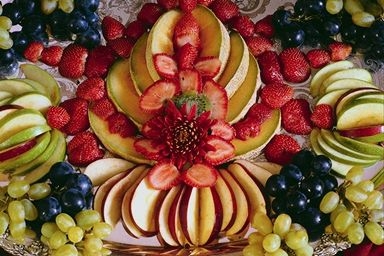Juicing Tips

General Juicing Tips
1.One pound of raw fruits or vegetables will generally yield 1 cup of fresh juice. This varies according to the type of fruit or vegetable used, and also varies from juicer to juicer, and is only a general guideline.
2.For clearer juice, you can filter the juice through folded layers of cheesecloth or a coffee filter.
3.Consume fresh juice immediately, as it begins to discolor and lose it's flavor and nutrient content very quickly.
4.You can store fresh juice for up to 24 hours if you keep it in an airtight container. Add a few drops of lemon juice to prevent discoloration.
5.Cut fruits and vegetables into small bite-sized pieces. Dice strawberries and separate oranges into sections. Smaller pieces will process better in the juicer.
6.Spice up your juice with add-ins such as a small bit of fresh ginger or mint.
7.Give your juice a healt boost with bee pollen, flax seeds, nuts soaked in water to soften them, or dairy products.
8.Thoroughly wash skin or rind of fruit or vegetables before juicing to remove harmful chemicals, or peel the fruit or vegetable before juicing to further eliminate chemicals from your juice. Skip both of these steps by using only organic produce.
9.Cut away all moldy, bruised, or damaged areas of your produce before juicing.
10.Place a plastic bag in the pulp receptacle of your juicer. When you're done juicing, you can throw away the pulp or use it in cooking and you won't need to wash the pulp receptacle.
Wheatgrass Juicing Tips
Measure wheatgrass in "rounds" like spaghetti. A one-inch round of wheatgrass yields about one ounce of juice.
Wheatgrass juicers aren't just for wheatgrass. You can also make juice from other fruits and vegetables--carrots, apples, oranges, strawberries, spinach, and so on.
Wheatgrass spoils quickly. If you are combining wheatgrass with other fruits and vegetables, use them first to ensure a fresh drink.
Fruit Juicing Tips
In general, the softer the fruit, the thicker the juice. Soft fruits like raspberries or strawberries yield a very thick juice. A firm fruit such as an apple or pineapple will yield a thinner juice.
Bananas, papayas and avocados don't work well in a juicer. You will get a thick purée instead of a juice.
Remember to remove hard pits from your fruit as they will damage your juicer.
If you are diabetic or have problems with blood sugar, stick to juicing vegetables.
Ninety-five percent of all the nutritional content of watermelon is in the rind.
Always peel mangos and papayas, whose skins contain an irritant that is harmful when consumed in quantity.
Citrus Juicing Tips
Room-temperature citrus fruits will yield more juice than those that are refrigerated.
Microwaving the citrus fruit for a few seconds before juicing will help extract more juice.
Use your palm to roll the citrus fruit around on the countertop a few times before juicing.
The peels of oranges, tangerines and grapefruits contain bitter, indigestible oils and must be removed before juicing.
Vegetable Juicing Tips
When juicing leafy greens such as lettuce or spinach, roll them into tight balls before placing them in your juicer.
Carrot greens and rhubarb greens are toxic and should be removed before juicing.
<< Back to Juice Extractors
|